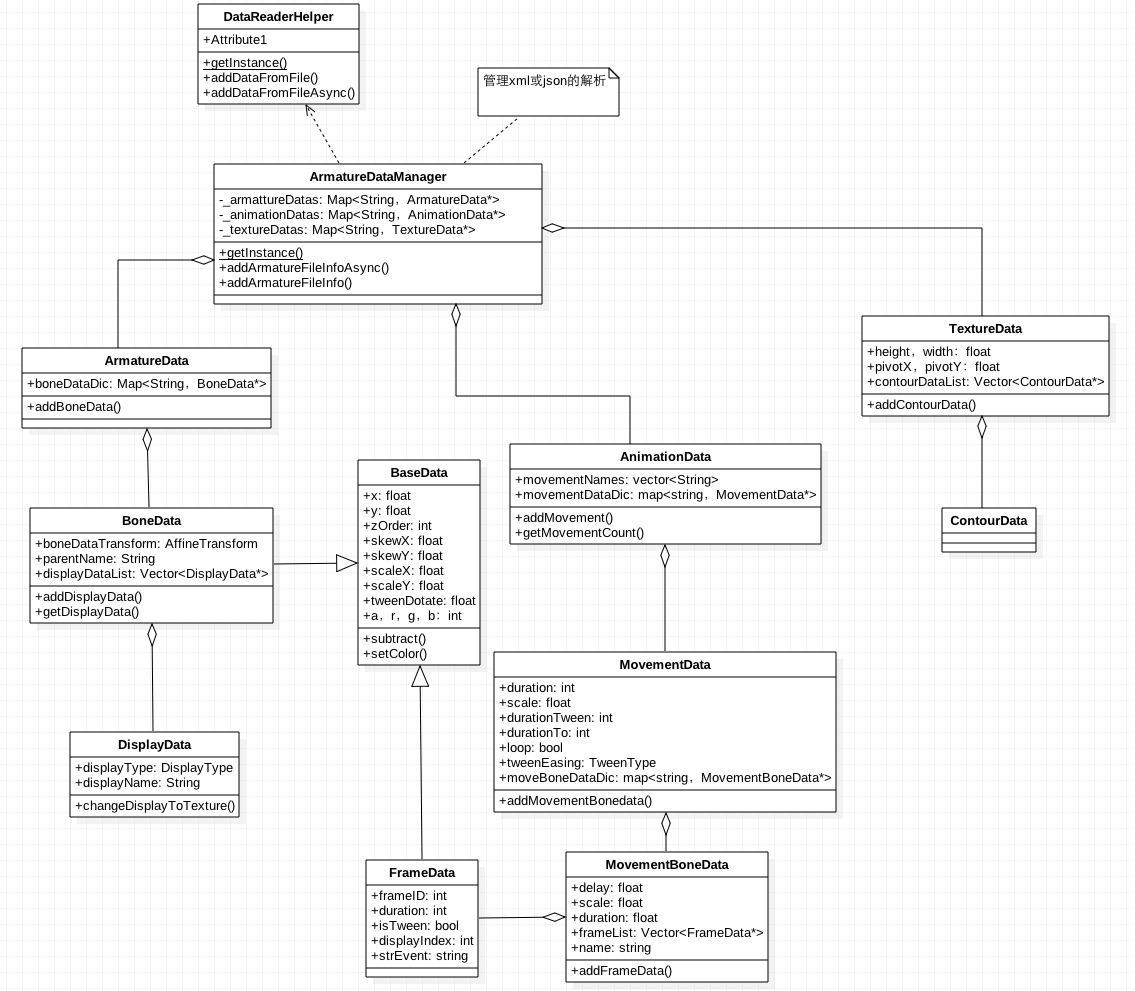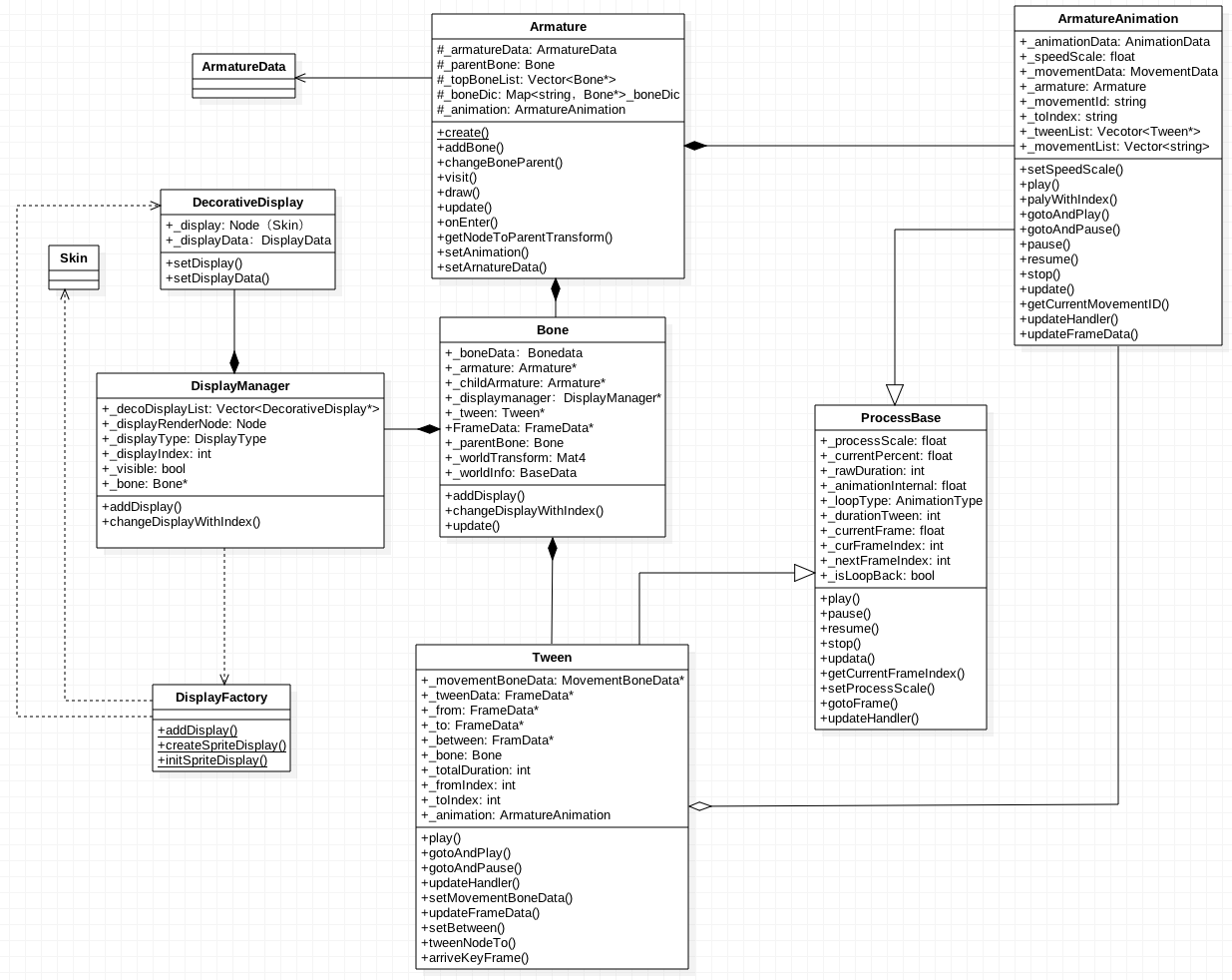cocos2dx의 뼈대 애니메이션 코드는 cocos -> editor-support -> win 아래의 필터를 통과하며 파일 구조는 다음과 같습니다. (맥에서는 포인트가 없고 덩어리만 되어있습니다)
armature(目录): animation(目录):动画控制相关。 CCProcessBase(文件): ProcessBase(类):CCTween和ArmatureAnimation的基类。 CCTWeen(文件): Tween(类):控制flash里一个layer的动画。 CCArmatureAnimation(文件): ArmatureAnimation(类):控制整个动画,内有多个Tween。 datas(目录):xml或json转成c++中直接用的数据结构。 CCDatas(文件): BaseData(类):BoneData、FrameData的基类,包含大小位置颜色等信息。 DisplayData(类): SpriteDisplayData、ArmatureDisplayData、ParticleDisplayData的基类。 SpriteDisplayData(类):骨骼中的显示数据。 ArmatureDisplayData(类): ParticleDisplayData(类): BoneData(类):单个骨骼数据,flash中一个layer是一个骨骼。 ArmatureData(类):骨骼数据,整个骨骼结构数据。 FrameData(类):关键帧数据。 MovementBoneData(类):带有关键帧的骨骼数据。 MovementData(类):一个完整动画数据。 AnimationData(类):组动画数据,包含多个MovementData。 ContourData(类): TextureData(类):显示图片数据。 utils(目录): CCArmatureDataManager(文件): RelativeData(类): ArmatureDataManager(类):管理ArmatureData、AnimationData、TextureData。 CCArmatureDefine(文件): CCDataReaderHelper(文件): _AsyncStruct(类): _DataInfo(类): DataReaderHelper(类):这正解析xml或json的类。 CCSpriteFrameCacheHelper(文件): SpriteFrameCacheHelper(类): CCTransformHelp(文件): TransformHelp(类):矩阵运算。 CCUtilMath(文件): CCArmature(文件): Armature(类):控制整个骨骼动画,内有ArmatureAnimation和ArmatureData。 CCBone(文件): Bone(类):骨骼控制类 display(目录):显示的图片管理。 CCBatchNode(文件): BatchNode(类): CCDecorativeDisplay(文件): DecorativeDisplay(类): CCDisplayFactory(文件): DisplayFactory(类): CCDisplayManager(文件): DisplayManager(类): CCSkin(文件): Skin(类): physics(目录):物理引擎相关,不分析。 ColliderFilter(文件): ColliderFilter(类): ColliderBody(类): ColliderDetecotor(类)
데이터 관련 소스코드
하위부터 상위까지 수업별 분석
데이터 관련 UML을 살펴보겠습니다. 일반적으로 ArmatureDataManager는 플래시에서 내보낸 xml 파일을 프로그램에서 직접 사용할 수 있도록 구문 분석하는 데 DataReaderHelper를 사용합니다. 예를 들어, FrameData는

기본데이터
BaseData: 뼈나 프레임의 위치, 회전, 색상 및 크기 조정을 나타내는 데 사용됩니다.
BaseData.h
class BaseData : public cocosd::Ref
{
public:
//Calculate two BaseData's between value(to - from) and set to self
virtual void subtract(BaseData *from, BaseData *to, bool limit);
public:
//位置,xml的x,y
float x;
float y;
//xml中z
int zOrder;
//旋转,xml的kX,kY
float skewX;
float skewY;
//缩放,xml的cX,cY
float scaleX;
float scaleY;
//啥??
float tweenRotate;
//颜色的变化属性
bool isUseColorInfo;
int a, r, g, b;
};FrameData, BoneData의 기본 클래스로 뼈 상태 정보를 제공합니다. 다음에서 볼 수 있듯이 BoneData는 xml의
본데이터
BoneData는 xml의
class BoneData : public BaseData
{
public:
void addDisplayData(DisplayData *displayData);
DisplayData *getDisplayData(int index);
public:
std::string name; //! the bone's name
std::string parentName; //! the bone parent's name
//! save DisplayData informations for the Bone
cocosd::Vector<DisplayData*> displayDataList;
//仿射变换,程序里好像没用这个属性
cocosd::AffineTransform boneDataTransform;
}; BoneData에는 이 뼈대(즉, DisplayData)에 스킨을 저장하는 데 사용되는 displayDataList가 있습니다. DisplayData는 xml 노드의
프레임데이터
FrameData는 플래시의 키 프레임 정보인 xml의
class FrameData : public BaseData
{
public:
int frameID;
//xml中dr,这一帧长度
int duration;
//不知要他干啥
bool isTween;
//xml中dI,显示哪个图
int displayIndex;
};디스플레이 데이터
DisplayData는 디스플레이 노드 정보를 나타내는 데 사용되는 SpriteDisplayData, ArmatureDisplayData 및 ParticleDisplayData의 상위 클래스입니다.
아마추어데이터
ArmatureData는 해당
class ArmatureData : public cocosd::Ref
{
public:
//添加骨骼信息
void addBoneData(BoneData *boneData);
BoneData *getBoneData(const std::string& boneName);
public:
std::string name;
//多个骨头信息
cocosd::Map<std::string, BoneData*> boneDataDic;
float dataVersion;
};애니메이션 데이터
AnimationData는 여러 MovementData를 포함하는
class AnimationData : public cocosd::Ref
{
public:
void addMovement(MovementData *movData);
MovementData *getMovement(const std::string& movementName);
ssize_t getMovementCount();
public:
//<animation name="Dragon">中的name
std::string name;
//所有带帧标签的动画map
cocosd::Map<std::string, MovementData*> movementDataDic;
//所有带帧标签的动画名
std::vector<std::string> movementNames;
};이동 데이터
MovementData는 xml의
class MovementData : public cocosd::Ref
{
public:
void addMovementBoneData(MovementBoneData *movBoneData);
MovementBoneData *getMovementBoneData(const std::string& boneName);
public:
std::string name;
//xml 中 dr
int duration;
//这怎么有个scale??
float scale;
//xml中to
int durationTo;
//xml中drTW
int durationTween;
//xml中lp
bool loop;
//带帧信息的骨骼
cocosd::Map<std::string, MovementBoneData*> movBoneDataDic;
};
MovementBoneData
MovementBoneData는 xml의
class MovementBoneData : public cocosd::Ref
{
void addFrameData(FrameData *frameData);
FrameData *getFrameData(int index);
public:
//xml中的dl
float delay;
//xml中的sc
float scale;
//这个和MovementData中的duration是不是一个??
float duration;
std::string name;
//关键帧信息
cocosd::Vector<FrameData*> frameList;
};간단한 요약
xml의 각 노드와 XXData의 대응관계는 다음과 같습니다. xml의 각 필드의 의미는 이전 글
에서 확인할 수 있습니다. 
애니메이션 생성과 관련된 코드를 살펴보겠습니다

ArmatureDataManager
ArmatureDataManager는 DataReaderHelper를 사용하여 armarureDatas, animationDatas 및 _textureDatas를 구문 분석합니다.
ArmatureDataManager는 단일 인스턴스입니다. 애니메이션이 사용될 때 ArmatureDataManager는 애니메이션을 생성하기 위한 데이터를 얻는 데 사용됩니다.
class ArmatureDataManager : public cocosd::Ref
{
public:
//单例
static ArmatureDataManager *getInstance();
static void destroyInstance();
public:
void addArmatureData(const std::string& id, ArmatureData *armatureData, const std::string& configFilePath = "");
ArmatureData *getArmatureData(const std::string& id);
void removeArmatureData(const std::string& id);
void addAnimationData(const std::string& id, AnimationData *animationData, const std::string& configFilePath = "");
AnimationData *getAnimationData(const std::string& id);
void removeAnimationData(const std::string& id);
void addTextureData(const std::string& id, TextureData *textureData, const std::string& configFilePath = "");
TextureData *getTextureData(const std::string& id);
void removeTextureData(const std::string& id);
void addArmatureFileInfo(const std::string& configFilePath);
const cocosd::Map<std::string, ArmatureData*>& getArmatureDatas() const;
const cocosd::Map<std::string, AnimationData*>& getAnimationDatas() const;
const cocosd::Map<std::string, TextureData*>& getTextureDatas() const;
protected:
void addRelativeData(const std::string& configFilePath);
RelativeData *getRelativeData(const std::string& configFilePath);
private:
cocosd::Map<std::string, ArmatureData*> _armarureDatas;
cocosd::Map<std::string, AnimationData*> _animationDatas;
cocosd::Map<std::string, TextureData*> _textureDatas;
std::unordered_map<std::string, RelativeData> _relativeDatas;
};
주로 armarureDatas, animationDatas, _textureDatas 세 가지 맵이 생성됩니다.
실행 시ArmatureDataManager::getInstance()->addArmatureFileInfo(“dragon.xml”);
이후 3개의 맵이 생성됩니다. addArmatureFileInfo 코드는 다음과 같습니다
void ArmatureDataManager::addArmatureFileInfo(const std::string& configFilePath)
{
addRelativeData(configFilePath);
_autoLoadSpriteFile = true;
DataReaderHelper::getInstance()->addDataFromFile(configFilePath);
}DataReaderHelper::getInstance()->addDataFromFile()이 다시 호출되어 DataReaderHelper가 실제로 데이터 구문 분석을 완료한 것을 볼 수 있습니다.
DataReaderHelper 클래스에는 xml의 특정 노드를 구문 분석하기 위한 여러 decodeXXX()(예: decodeArmature, decodeBone)가 있습니다. 구경해보세요
addDataFromFile 코드:
void DataReaderHelper::addDataFromFile(const std::string& filePath)
{
//省略一些代码
DataInfo dataInfo;
dataInfo.filename = filePathStr;
dataInfo.asyncStruct = nullptr;
dataInfo.baseFilePath = basefilePath;
if (str == ".xml")
{
DataReaderHelper::addDataFromCache(contentStr, &dataInfo);
}
else if(str == ".json" || str == ".ExportJson")
{
DataReaderHelper::addDataFromJsonCache(contentStr, &dataInfo);
}
else if(isbinaryfilesrc)
{
DataReaderHelper::addDataFromBinaryCache(contentStr.c_str(),&dataInfo);
}
CC_SAFE_DELETE_ARRAY(pBytes);
}다른 파일(xml, json, 바이너리) 구문 분석 방법에 해당합니다. xml은 addDataFromCache를 사용합니다
void DataReaderHelper::addDataFromCache(const std::string& pFileContent, DataInfo *dataInfo)
{
tinyxml::XMLDocument document;
document.Parse(pFileContent.c_str());
tinyxml::XMLElement *root = document.RootElement();
CCASSERT(root, "XML error or XML is empty.");
root->QueryFloatAttribute(VERSION, &dataInfo->flashToolVersion);
/*
* Begin decode armature data from xml
*/
tinyxml::XMLElement *armaturesXML = root->FirstChildElement(ARMATURES);
tinyxml::XMLElement *armatureXML = armaturesXML->FirstChildElement(ARMATURE);
while(armatureXML)
{
ArmatureData *armatureData = DataReaderHelper::decodeArmature(armatureXML, dataInfo);
if (dataInfo->asyncStruct)
{
_dataReaderHelper->_addDataMutex.lock();
}
ArmatureDataManager::getInstance()->addArmatureData(armatureData->name.c_str(), armatureData, dataInfo->filename.c_str());
armatureData->release();
if (dataInfo->asyncStruct)
{
_dataReaderHelper->_addDataMutex.unlock();
}
armatureXML = armatureXML->NextSiblingElement(ARMATURE);
}
/*
* Begin decode animation data from xml
*/
tinyxml::XMLElement *animationsXML = root->FirstChildElement(ANIMATIONS);
tinyxml::XMLElement *animationXML = animationsXML->FirstChildElement(ANIMATION);
while(animationXML)
{
AnimationData *animationData = DataReaderHelper::decodeAnimation(animationXML, dataInfo);
if (dataInfo->asyncStruct)
{
_dataReaderHelper->_addDataMutex.lock();
}
ArmatureDataManager::getInstance()->addAnimationData(animationData->name.c_str(), animationData, dataInfo->filename.c_str());
animationData->release();
if (dataInfo->asyncStruct)
{
_dataReaderHelper->_addDataMutex.unlock();
}
animationXML = animationXML->NextSiblingElement(ANIMATION);
}
/*
* Begin decode texture data from xml
*/
tinyxml::XMLElement *texturesXML = root->FirstChildElement(TEXTURE_ATLAS);
tinyxml::XMLElement *textureXML = texturesXML->FirstChildElement(SUB_TEXTURE);
while(textureXML)
{
TextureData *textureData = DataReaderHelper::decodeTexture(textureXML, dataInfo);
if (dataInfo->asyncStruct)
{
_dataReaderHelper->_addDataMutex.lock();
}
ArmatureDataManager::getInstance()->addTextureData(textureData->name.c_str(), textureData, dataInfo->filename.c_str());
textureData->release();
if (dataInfo->asyncStruct)
{
_dataReaderHelper->_addDataMutex.unlock();
}
textureXML = textureXML->NextSiblingElement(SUB_TEXTURE);
}
}여기에는 decodeArmature, decodeAnimation 및 decodeTexture라는 세 가지 while이 있습니다. ArmatureData, AnimationData 및 TextureData를 생성한 후 ArmatureDataManager::getInstance()->addArmatureData, addAnimationData 및 addTextureData가 ArmatureDataManager의 해당 맵에 추가됩니다. . decodeXXX에서는 다양한 decodeXX가 호출되어 해당 XXXData를 생성합니다.
아마추어
xml 데이터를 로드한 후
을 호출합니다.
armature = Armature::create("Dragon");
armature->getAnimation()->play("walk");
armature->getAnimation()->setSpeedScale();
armature->setPosition(VisibleRect::center().x, VisibleRect::center().y * .f);
armature->setScale(.f);
addChild(armature);便展示了动画,那么这是如何做到的呢?
Armature部分代码如下,ArmatureAnimation控制xml的mov节点,Bone中有Tween,这个Tween对应xml中b(MovementBoneData)
class Armature: public cocosd::Node, public cocosd::BlendProtocol {
protected:
//要展示动画的ArmatureData
ArmatureData *_armatureData;
BatchNode *_batchNode;
Bone *_parentBone;
float _version;
mutable bool _armatureTransformDirty;
//所有Bone
cocosd::Map<std::string, Bone*> _boneDic; cocosd::Vector<Bone*> _topBoneList;
cocosd::BlendFunc _blendFunc;
cocosd::Vec _offsetPoint;
cocosd::Vec _realAnchorPointInPoints;
//动画控制器
ArmatureAnimation *_animation;
};
Bone
部分代码如下,tweenData为当前Bone的状态,每帧都会更新这个值,并用tweenData确定worldInfo,提供Skin显示信息。tween为骨头的整个动画过程。
class Bone: public cocosd::Node {
protected:
BoneData *_boneData;
//! A weak reference to the Armature
Armature *_armature;
//! A weak reference to the child Armature
Armature *_childArmature;
DisplayManager *_displayManager;
/*
* When Armature play an animation, if there is not a MovementBoneData of this bone in this MovementData, this bone will be hidden.
* Set IgnoreMovementBoneData to true, then this bone will also be shown.
*/
bool _ignoreMovementBoneData;
cocosd::BlendFunc _blendFunc;
bool _blendDirty;
Tween *_tween; //! Calculate tween effect
//! Used for making tween effect in every frame
FrameData *_tweenData;
Bone *_parentBone; //! A weak reference to its parent
bool _boneTransformDirty; //! Whether or not transform dirty
//! self Transform, use this to change display's state
cocosd::Mat _worldTransform;
BaseData *_worldInfo;
//! Armature's parent bone
Bone *_armatureParentBone;
};
Tween
这个是每个骨头的动画过程,见下面的movementBoneData。tweenData是Bone中tweenData的引用,在这每帧会计算这个tweenData值。
class Tween : public ProcessBase{
protected:
//! A weak reference to the current MovementBoneData. The data is in the data pool
MovementBoneData *_movementBoneData;
FrameData *_tweenData; //! The computational tween frame data, //! A weak reference to the Bone's tweenData
FrameData *_from; //! From frame data, used for calculate between value
FrameData *_to; //! To frame data, used for calculate between value
// total diff guan
FrameData *_between; //! Between frame data, used for calculate current FrameData(m_pNode) value
Bone *_bone; //! A weak reference to the Bone
TweenType _frameTweenEasing; //! Dedermine which tween effect current frame use
int _betweenDuration; //! Current key frame will last _betweenDuration frames
// 总共运行了多少帧 guan
int _totalDuration;
int _fromIndex; //! The current frame index in FrameList of MovementBoneData, it's different from m_iFrameIndex
int _toIndex; //! The next frame index in FrameList of MovementBoneData, it's different from m_iFrameIndex
ArmatureAnimation *_animation;
bool _passLastFrame; //! If current frame index is more than the last frame's index
};
ArmatureAnimation
控制动画的播放,看到_tweenList,所有骨头的集合就是动画了。
class ArmatureAnimation : public ProcessBase {
protected:
//! AnimationData save all MovementDatas this animation used.
AnimationData *_animationData;
MovementData *_movementData; //! MovementData save all MovementFrameDatas this animation used.
Armature *_armature; //! A weak reference of armature
std::string _movementID; //! Current movment's name
int _toIndex; //! The frame index in MovementData->m_pMovFrameDataArr, it's different from m_iFrameIndex.
cocos2d::Vector<Tween*> _tweenList;
}如何做到每帧更新骨头的信息?
addChild(armature)后,Armaure中的onEnter(node进入舞台就会调用,比如addchild),onEnter调scheduleUpdate调scheduleUpdateWithPriority调_scheduler->scheduleUpdate。这样就每帧调用armature的update。
void Armature::update(float dt)
{
_animation->update(dt);
for(const auto &bone : _topBoneList) {
bone->update(dt);
}
_armatureTransformDirty = false;
}
又调用了animation->update(dt);及遍历调用bone->update(dt);animation->update(dt)如下:
void ArmatureAnimation::update(float dt)
{
ProcessBase::update(dt);
for (const auto &tween : _tweenList)
{
tween->update(dt);
}
//省略一堆代码
}
又调用了tween->update(dt); 每一个update都会调用updateHandler(ProcessBase中update调用了update里调用updateHandler)
void Tween::updateHandler()
{
//省略一堆代码
if (_loopType > ANIMATION_TO_LOOP_BACK)
{
percent = updateFrameData(percent);
}
if(_frameTweenEasing != ::cocosd::tweenfunc::TWEEN_EASING_MAX)
{
tweenNodeTo(percent);
}
}
tweenNodeTo调用了tweenNodeTo,其中的tweenData其实就是Bone的tweenData。根据percent计算了_tweenData的变化量。
FrameData *Tween::tweenNodeTo(float percent, FrameData *node)
{
node = node == nullptr ? _tweenData : node;
if (!_from->isTween)
{
percent = ;
}
node->x = _from->x + percent * _between->x;
node->y = _from->y + percent * _between->y;
node->scaleX = _from->scaleX + percent * _between->scaleX;
node->scaleY = _from->scaleY + percent * _between->scaleY;
node->skewX = _from->skewX + percent * _between->skewX;
node->skewY = _from->skewY + percent * _between->skewY;
_bone->setTransformDirty(true);
if (node && _between->isUseColorInfo)
{
tweenColorTo(percent, node);
}
return node;
}
转了一大圈终于在每帧更新了Bone中的tweenData,最后看Bone的update,其根据tweenData计算了worldInfo、worldTransform。而且updateDisplay更新skin的信息,staticcast
void Bone::update(float delta)
{
if (_parentBone)
_boneTransformDirty = _boneTransformDirty || _parentBone->isTransformDirty();
if (_armatureParentBone && !_boneTransformDirty)
{
_boneTransformDirty = _armatureParentBone->isTransformDirty();
}
if (_boneTransformDirty)
{
if (_dataVersion >= VERSION_COMBINED)
{
TransformHelp::nodeConcat(*_tweenData, *_boneData);
_tweenData->scaleX -= ;
_tweenData->scaleY -= ;
}
_worldInfo->copy(_tweenData);
_worldInfo->x = _tweenData->x + _position.x;
_worldInfo->y = _tweenData->y + _position.y;
_worldInfo->scaleX = _tweenData->scaleX * _scaleX;
_worldInfo->scaleY = _tweenData->scaleY * _scaleY;
_worldInfo->skewX = _tweenData->skewX + _skewX + _rotationZ_X;
_worldInfo->skewY = _tweenData->skewY + _skewY - _rotationZ_Y;
if(_parentBone)
{
applyParentTransform(_parentBone);
}
else
{
if (_armatureParentBone)
{
applyParentTransform(_armatureParentBone);
}
}
TransformHelp::nodeToMatrix(*_worldInfo, _worldTransform);
if (_armatureParentBone)
{
_worldTransform = TransformConcat(_worldTransform, _armature->getNodeToParentTransform());
}
}
DisplayFactory::updateDisplay(this, delta, _boneTransformDirty || _armature->getArmatureTransformDirty());
for(const auto &obj: _children) {
Bone *childBone = static_cast<Bone*>(obj);
childBone->update(delta);
}
_boneTransformDirty = false;
如何展示(draw)出图片(skin)
Armature诗歌node,加入父节点后会调用其draw函数,遍历draw了bone的显示元素。
void Armature::draw(cocosd::Renderer *renderer, const Mat &transform, uint_t flags)
{
if (_parentBone == nullptr && _batchNode == nullptr)
{
// CC_NODE_DRAW_SETUP();
}
for (auto& object : _children)
{
if (Bone *bone = dynamic_cast<Bone *>(object))
{
Node *node = bone->getDisplayRenderNode();
if (nullptr == node)
continue;
switch (bone->getDisplayRenderNodeType())
{
case CS_DISPLAY_SPRITE:
{
Skin *skin = static_cast<Skin *>(node);
skin->updateTransform();
BlendFunc func = bone->getBlendFunc();
if (func.src != _blendFunc.src || func.dst != _blendFunc.dst)
{
skin->setBlendFunc(bone->getBlendFunc());
}
else
{
skin->setBlendFunc(_blendFunc);
}
skin->draw(renderer, transform, flags);
}
break;
case CS_DISPLAY_ARMATURE:
{
node->draw(renderer, transform, flags);
}
break;
default:
{
node->visit(renderer, transform, flags);
// CC_NODE_DRAW_SETUP();
}
break;
}
}
else if(Node *node = dynamic_cast<Node *>(object))
{
node->visit(renderer, transform, flags);
// CC_NODE_DRAW_SETUP();
}
}
}
再skin->draw(renderer, transform, flags);会用到刚刚更新的_quad,显示出最新的图片信息。
{
Mat mv = Director::getInstance()->getMatrix(MATRIX_STACK_TYPE::MATRIX_STACK_MODELVIEW);
//TODO implement z order
_quadCommand.init(_globalZOrder, _texture->getName(), getGLProgramState(), _blendFunc, &_quad, , mv);
renderer->addCommand(&_quadCommand);
}
至此,大家对cocos2dx里的骨骼动画应该有了全面的认识,三篇文章介绍的比较粗糙,其实有些细节内容我也没看懂,不过不要在意这些细节,没有实际的改动需求的话,懂80%就可以了,细节可以需要的时候在仔细理解。